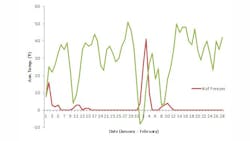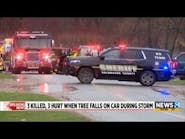Tools & Technologies: “Do Sprinklers Cause More Damage Than They’re Worth?”
Those who advocate to protect our future homes and businesses with fire sprinkler systems are often asked “do sprinklers cause more damage than they’re worth?” Sometimes, average citizens ask this question because they believe all the sprinkler heads activate at the same time, just like in the movies.
Sometimes the question comes from those on the front lines – our firefighters. Their reason for asking this question might be based on real-life experience. With all the new fire protection systems being installed and very few fires to prove their worth, firefighters mostly see the negative side of the systems – false alarms. When that false alarm is caused by a forklift breaking sprinkler pipe, the firefighters typically see a lot of water damage. When bitter cold temperatures arrive and the firefighters spend their days cleaning up the mess from frozen sprinkler pipes, they begin to wonder if it’s worth it. When fire sprinkler systems are seen as a source of significant property damage, this contradicts the very reason why sprinklers were installed – to prevent loss.
The South Metro Fire Rescue Authority (SMFRA) took up the challenge to better understand our false alarms and develop strategies to reduce them. The department started a false alarm mitigation group in 2011. SMFRA protects a fairly modern, suburban community south of Denver, Colorado with close to 40% of its commercial occupancies having fire sprinkler and/or fire alarm systems. Additionally, close to 2,000 single-family homes are protected by fire sprinkler systems. Fire protection systems in general produce about 2,300 false alarms annually (NFIRS Incident Codes 700-799), or about 15% of the overall call volume. While frozen sprinkler pipes account for a small percentage of false alarms, the winter of 2011 quickly pointed out the need to track, analyze, and eliminate them.
The Cold Snap of 2011
During the period from January 1st through February 11, 2011, the Denver area experienced periods of extreme cold and SMFRA felt its wrath while responding to close to 150 sprinkler pipe freezes and about 65 domestic plumbing freezes. The six-week time period was marked by several days of snow and cold where low temperatures dropped well below 0°F, and daytime temperatures varied widely from a high of 67°F on January 28th to a high of -3°F on February 1st. The sprinkler pipe freezes peaked when low temperatures dropped below zero and continued for a day or two as high temperatures climbed back into the 30’s or 40’s. Figure 1 shows the strong relationship between drop in average temperature and the rise in the number of freezes during January and February. The warming trend after a deep freeze also appeared to be an accurate indicator of responses related to pipe freezes, as 66% of them occurred between 1000 and 1900 hours and most between 1300 and 1500 hours.
SMFRA has approximately 5,000 occupancies that are partially or completely protected by a fire sprinkler system. Most sprinkler systems are found in multi-family residences, business offices, and retail uses. The pipe freezes occurred throughout much of SMFRA, but mostly in multifamily residences, business offices, hotels/motels, and schools. No responses to frozen sprinkler pipes occurred in one- and two-family residence sprinkler systems during the six-week period of 2011. There were approximately 100 addresses that had one or more sprinkler pipe freezes, or about 2% of all occupancies that have a sprinkler system. Firefighters spent a total of 23 hours on pipe freeze incident scenes during the six-week period.
From incident reports, inspection results, and follow-up interviews, the causes of the sprinkler pipe freezes were determined (see Figure 2). When a cause was known, over half of the pipe freezes were due to some error in the design or installation of the sprinkler system, often insufficient insulation, antifreeze, or other form of freeze protection. The remainder were due to some human error, which most frequently included turning off heat in vacant areas, failing to turn on heaters (often in exterior storage closets), and failing to drain drum drips on dry systems.
According to the Rocky Mountain Insurance Information Association, there were more than $25 Million in insured losses in Colorado during the first week of February alone. They do not track pipe freezes (domestic or sprinkler) separately, so it is not known what they contributed to the overall loss. SMFRA personnel interviewed nine businesses to get a sample of the damage and dollar loss experienced in our jurisdiction. This task was difficult, as several businesses were unable or unwilling to provide loss information and estimates given were very rough. From the information available, the overall dollar loss ranged from very nominal fees to add heaters in a room to potentially over a million dollars for a hotel that lost business for several months. The average loss per pipe break was about $5,400.
The Calm after the Storm
Immediately following the cold snaps of 2011, SMFRA personnel went into action working with property owners to get systems back in service and make corrections that would help to prevent future incidents. Fortunately, the winter of 2012 was mild, which also gave the false alarm mitigation group time to strategize. Some of the efforts made to mitigate the problem of sprinkler pipe freezes included:
- Installing heaters and improving maintenance practices to turn on heat prior to the onset of winter;
- Improving maintenance practices to drain drum drips;
- Removing non-required sprinkler heads wherever possible, such as from outside storage closets in apartments;
- Installing insulation where known to be missing;
- Converting systems to antifreeze where appropriate;
- Replacing antifreeze solutions that had been “watered down”;
- Corrections to dry systems such as replacing pipe and restoring proper pipe pitch;
- A flyer was developed to reduce the number of human-caused pipe freezes by reminding businesses to prepare for the winter. These were hand-delivered by inspectors and firefighters to apartments, hotels, and schools. The flyer was also distributed through the South Metro Chamber of Commerce.
- A system was set up to alert inspectors of repeat false alarms at an address in order to intervene and prevent future activations, including pipe freezes.
- A Building Owner’s Guide was developed that includes highlights on sprinkler system maintenance and pipe freeze avoidance.
- Plan review practices have been evaluated to avoid non-required sprinkler heads in areas prone to freezing.
- Inspection practices have be evaluated to improve verification of proper freeze protection measures between rough-in and final.
The Impact
The interventions by SMFRA personnel, particularly the improvement in annual maintenance, removal of non-required sprinklers in apartment exterior closets, and annual reminders to property managers, appear to have had a positive impact in reducing sprinkler pipe freezes. Figure 3 shows the number of pipe freezes by month from 2011-2013. Since the winter of 2013/2014 had cold periods very similar to 2011, it was appropriate to compare data between these two years to start measuring the impact of SMFRA’s interventions.
About 80% of the addresses that experienced a sprinkler pipe freeze in 2011 did not have a repeat incident in 2012 or 2013. SMFRA’s interventions particularly had a dramatic impact on the top offenders of 2011 and most of them did not experience any further problems in 2012 or 2013 (see Table 1).
Table 1. Top Offender Sprinkler Pipe Freeze Locations, 2011-2013.
|
# of Pipe Freezes |
||
|
Business Name |
2011 |
2013 |
|
Condominium Complex |
13 |
0 |
|
Apartment Complex |
9 |
0 |
|
Apartment Complex |
6 |
4 |
|
High-Rise Office Building |
5 |
1 |
|
Apartment Complex/Parking Garage |
4 |
2 |
|
Apartment Complex |
3 |
0 |
|
Apartment Complex |
3 |
0 |
Sprinkler pipe freezes due to maintenance issues were continuing to decrease and by February, 2014, the main issues continued to be heating problems and lack of insulation during system installation (see Figures 4a and 4b).
The three years of data also helped to verify which occupancy types are most fertile for future interventions. Table 2 provides a Property Use Alarm Index, which shows the ratio of pipe freezes to the number of sprinkler systems in each property use. The index provides a better comparison between property uses and shows that multifamily residences, hotels/motels, schools, and parking garages had service demands that were disproportionately high.
Table 2. Property Use Alarm Index, Pipe Freezes, 2011-2013.
|
Property Use |
% of Pipe Freezes |
% of Sprinklered Occupancies |
Property Use Alarm Index |
|
Multifamily residences |
40.6 |
13.6 |
3.0 |
|
Business office |
17.9 |
13 |
1.4 |
|
Hotels/motels |
7.7 |
0.9 |
8.5 |
|
Retail |
7.7 |
10.8 |
0.7 |
|
Restaurants/bars |
6.4 |
4.1 |
1.6 |
|
Schools under 12th grade |
4.7 |
1.9 |
2.5 |
|
Parking garage |
3.4 |
0.3 |
11.4 |
|
Churches |
0.4 |
1.0 |
0.4 |
|
1 & 2-family residences |
1.7 |
38.1 |
0.0 |
Unfortunately, there were four sprinkler pipe freezes in one- and two-family dwellings in 2013, as compared to none in 2011. A separate research effort highlighted the fact that many of SMFRA’s homeowners have little knowledge about how their sprinkler systems work and how they should be maintained. In particular, many of the systems were designed with antifreeze and had not been checked for 10 or more years.
Conclusion
Fire sprinkler systems are an integral part of a balanced approach to preventing, mitigating, and responding to fire emergencies. Unnecessary activations of those systems can result in property damage and put firefighters and citizens at risk. Equally important, citizen and firefighter trust in these life-saving systems can erode quickly.
Sprinkler advocates can get frustrated when people ask “do sprinklers cause more damage than they’re worth” because it’s often based on a misunderstanding or an anecdotal story from years ago. But, it’s also an emotion-stirring argument that gets people’s attention, especially political leaders. So, the fire service needs to counter those arguments with accurate data collection and analysis. We also need to view sprinkler system maintenance as not just the building owner’s responsibility. Rather, we need to figure out where our inspection practices have fallen short and ask ourselves during a plan review if more sprinklers in a building are better, especially non-required sprinklers in an outdoor storage closet prone to freezing. We need to embrace the opportunity to partner with building owners – to educate, take a proactive approach to the coming winter, and help them appreciate the awesome fire protection they have. This partnership also prevents unnecessary property damage and keeps firefighters from endangering themselves and citizens when responding to false alarms.
Finally, for home fire sprinkler advocates…remember, studies have shown that people who already live in a home with sprinklers are more likely to insist that their next home also has sprinklers. So while you’re working hard to get all new homes protected by fire sprinkler systems, don’t forget about the ones who already have them…they’re your grass-roots advocates for tomorrow.
Michael E. Dell'Orfano | Deputy Chief
MICHAEL E. DELL’ORFANO, EFO, is deputy chief of the South Metro Fire Rescue Authority and chair of the Colorado Fire Sprinkler Coalition. He is a 22-year veteran of the fire service, serving in roles from paid-call firefighter to fire marshal to deputy fire chief. He has a master of science degree in fire protection engineering and is a graduate of the National Fire Academy Executive Fire Officer Program.






